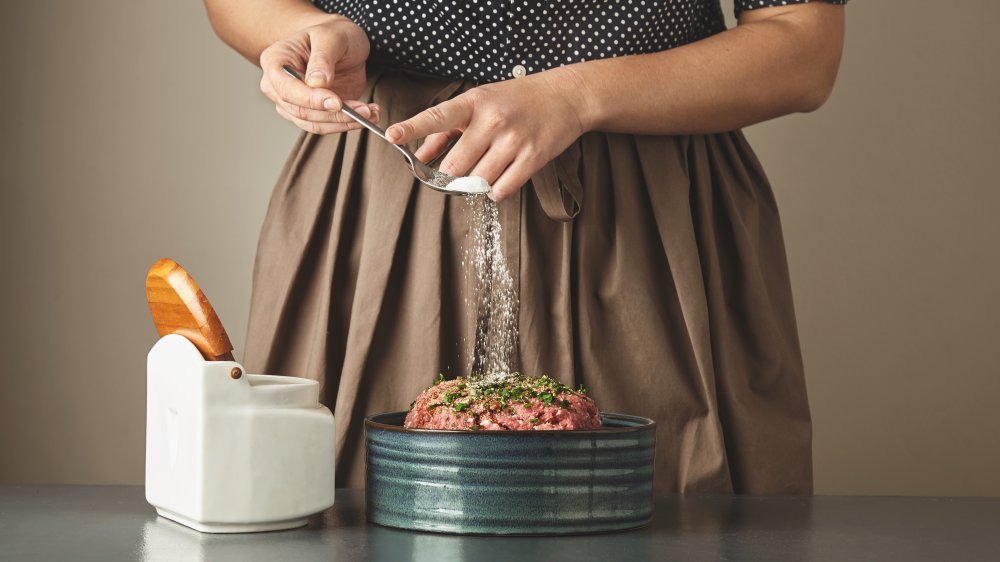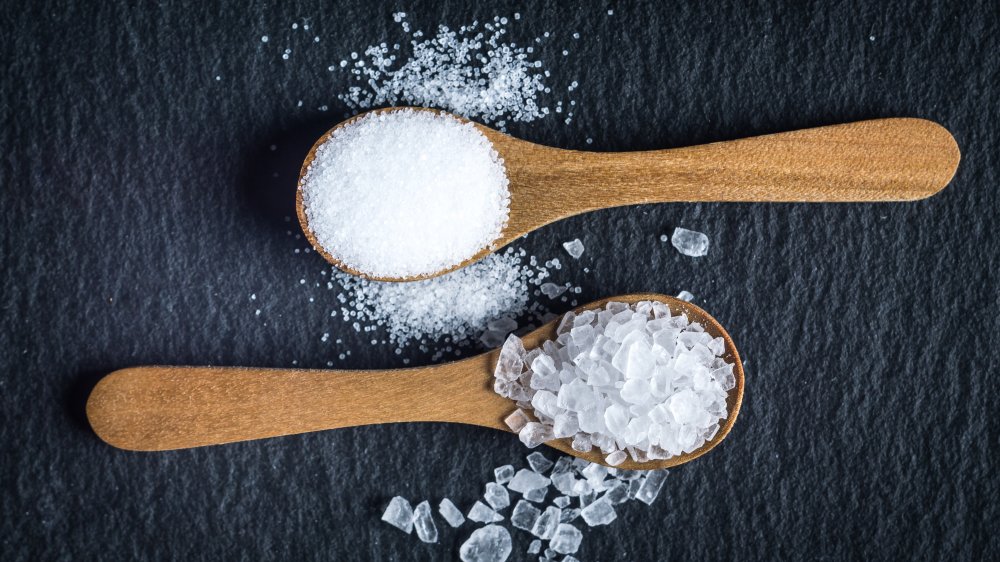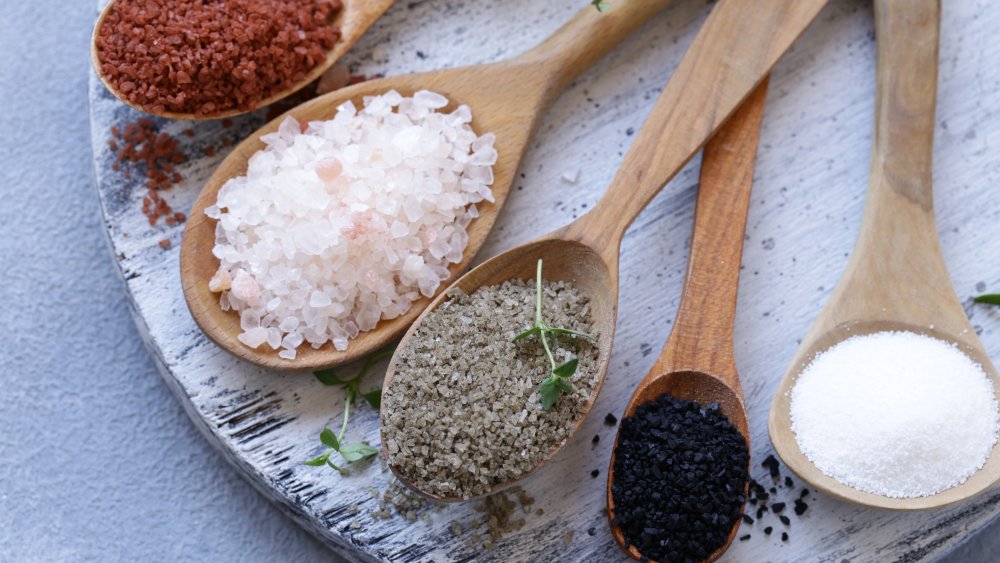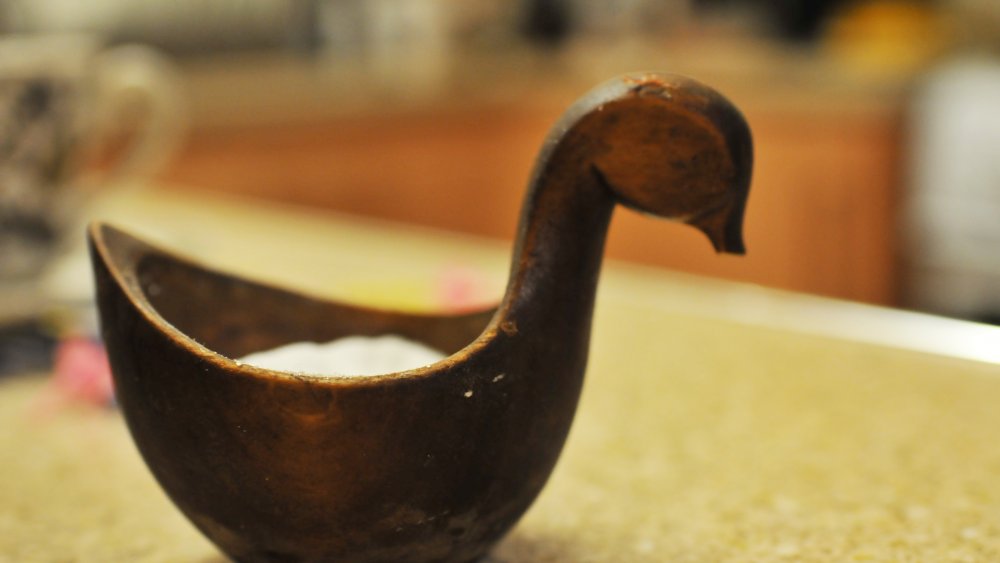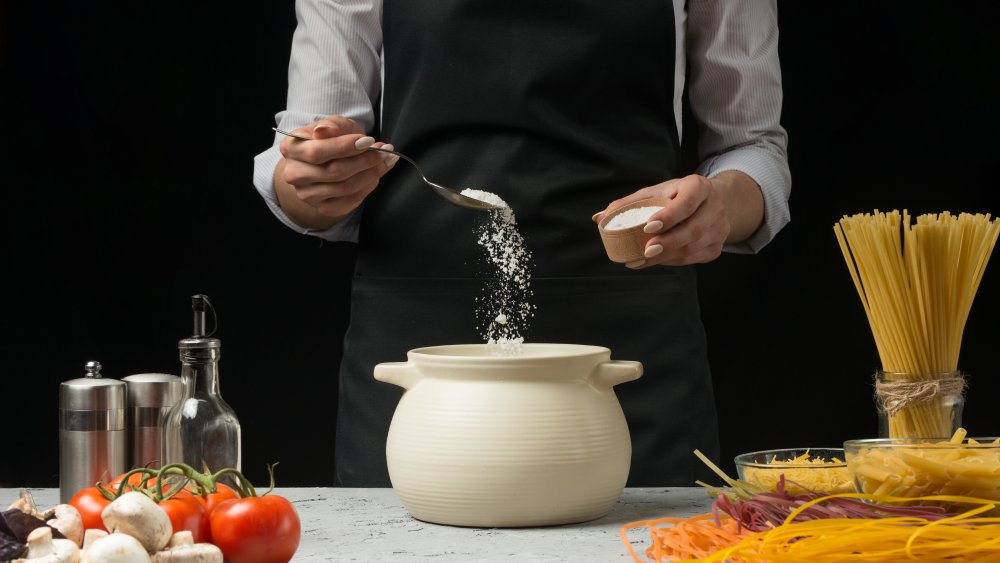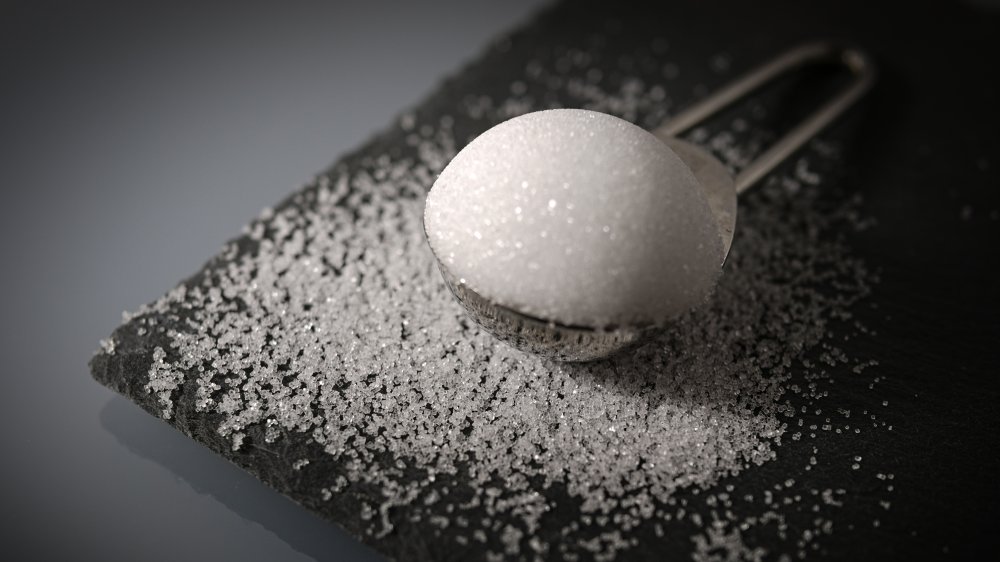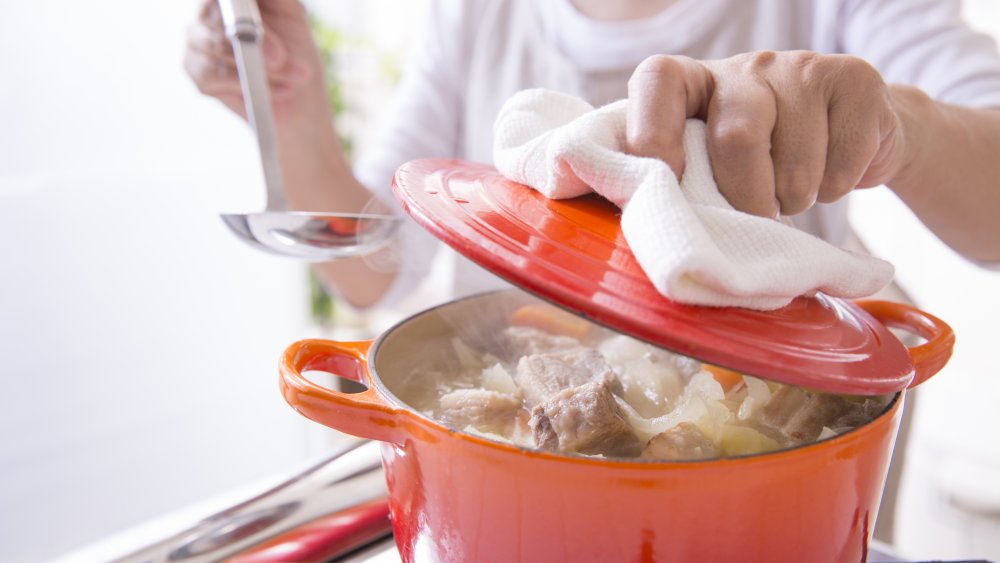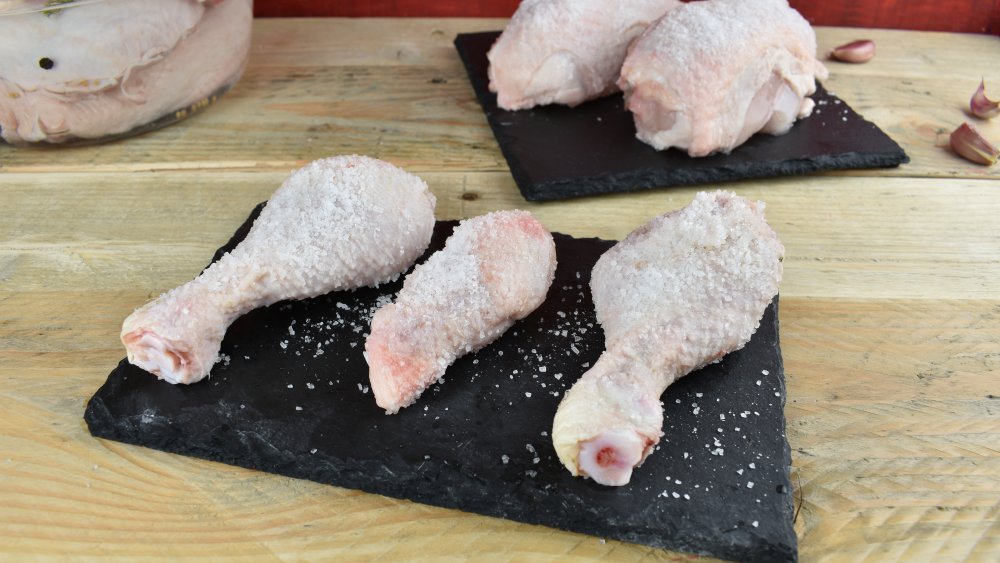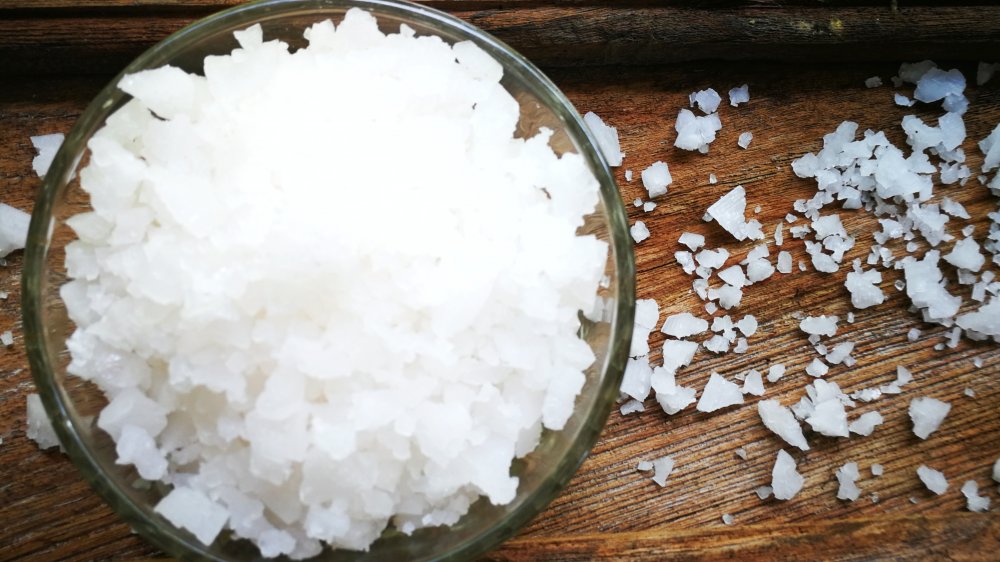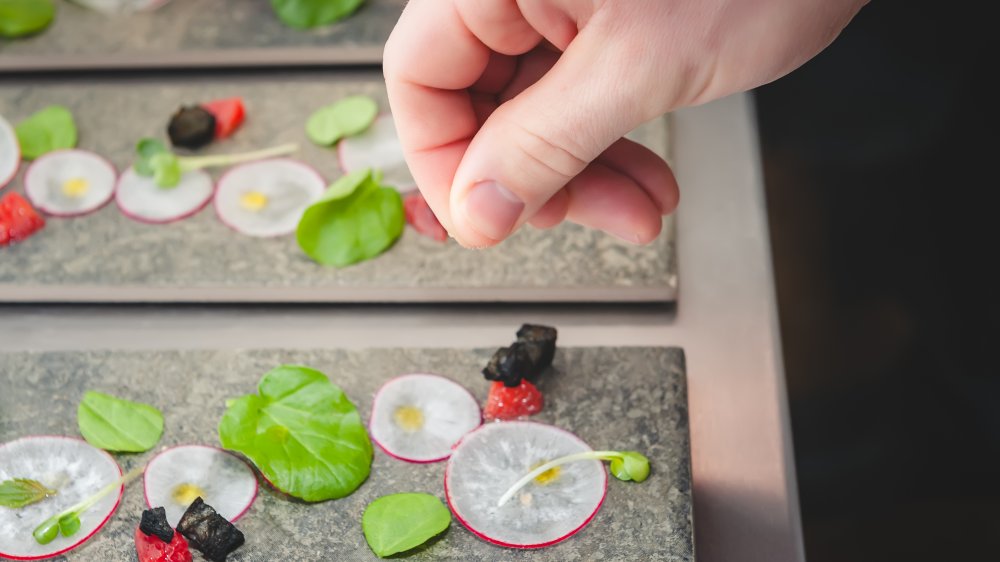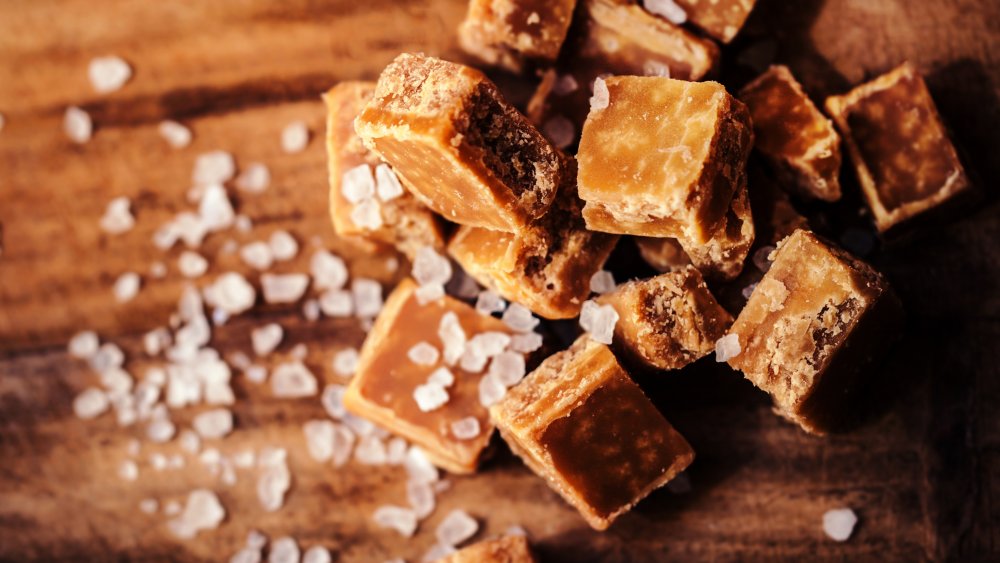Mistakes Everyone Makes When Cooking With Salt
Salt is in everyone's kitchen cabinets, it's on countless tables, and it's a staple no cook wants to run out of. We all know it's important, but there's a lot of mistakes that are made with it, too. And when you make one of those mistakes, you — and everyone who's over for dinner — can tell.
Humankind has been using salt since somewhere around 6050 BC to flavor their food, and according to SaltWorks, it's been much more important than you'd think a role as everyday seasoning would make it. It was the backbone of trade and commerce in the ancient world, an important part of religious ceremonies in places like ancient Egypt, and it was a form of currency. It seems almost unreal to think that this nondescript box that sits in our kitchens once shaped history, but it absolutely did.
We've come a long way since then, but it turns out we're still learning quite a bit about this staple seasoning. There's a right way and a very wrong way to use it, and knowing the secrets of salt will go a long way in making your meals that much closer to perfect. Let's talk salt mistakes, and how to fix them.
You're using the wrong kind of salt
Quick, how many different types of salt do you have in your kitchen? One? Two? Here's the thing — there are a few different staple varieties that, depending on what you like to cook, you should definitely have on hand.
First, the most common: table salt. That's usually the one most people just grab, and it's great for baking, last-minute seasoning, and yes, for leaving on the table. Webstaurant Store puts that in the same category as other types of fine salt, and there are a few varieties you might run across — like canning and pickling salt. Those are super fine and extra concentrated, and that means you're not going to want to bake with those or put them on the table; your taste buds will regret it!
You've probably also come across different types of rock salt, like kosher salt, curing salt, pretzel salt, and Himalayan pink salt. Since these types of salt have bigger grains, they're easier to spread more evenly across a surface. That means they're a much better choice for dishes where you're seasoning the surface without stirring. Think of things like topping breads and pretzels, or cuts of meat.
So, when in doubt, just remember: stir with table salt, sprinkle with rock salt. Easy!
You're skipping over some funky kinds of salt
It's very possible that you're missing out on something that will take your signature dish to the next level, and Wide Open Eats says that might just be some funky salt.
Take red and black Hawaiian salt (which Webstaurant Store notes is also known as lava salt). If your favorite meals include a pork or seafood dish, you might want to try finishing it off with black Hawaiian salt. Harvested from Hawaii's volcanic islands and turned black by the addition of charcoal, it has a slightly briny and surprisingly tasty sulfuric flavor that could be perfect with the right fishy flavor profile.
There's red Hawaiian salt, too, and that's a bit more mild and is mixed with red clay instead of charcoal. Try that just once with seafood, jerky, and traditional Hawaiian dishes, and it'll become a kitchen staple.
If you love the distinctive taste of smoked meats, you can get that with smoked salt, too. It's salt that's been slowly smoked over a wood fire for up to two weeks, and when you add it to the veggies you serve alongside your smoked ribs or brisket, it's a total win.
Or maybe, you make a mean homemade caramel. Try salting it with fleur de sel salt, a pricey salt that comes only from the waters off France's coast. You'll definitely pay a little more, but this briny, blue-grey salt will help create the perfect salted caramel bite.
You're not keeping salt stored correctly or close at hand
How do you store your salt? In a shaker, maybe, or in the box it came in? Is it tucked away in your kitchen cupboard? That's not the best place for it, and here's why: it's not easily accessible.
If adding a pinch of salt means you're not going to be opening cabinets, digging through boxes, and opening containers, you're more likely to do it, aren't you? That's what makes salt cellars — and particularly the wide-mouth salt pig — such an invaluable addition to any kitchen. Serious Eats says it's not just having a dedicated container that's important, it's also a matter of getting one you can easily reach into, and keep close at hand.
Fortunately, the foodie movement has made sure that these handy storage containers have become as popular as avocado toast, and that means there are plenty of options out there. Wood or ceramic, metal or plastic, there's a size, shape, and look that's a perfect fit for your kitchen. Here's a tip, though — make sure you get one that's big enough to comfortably fit your fingers.
Getting your salt ratio wrong for pasta
Getting the right amount of salt in a dish can be tricky, and for many dishes, it's all down to personal taste. When it comes to pasta, though, the rules are a little more concrete.
Chef Albert Di Meglio talked to Today about what he'd learned after not just spending years in the business, but also growing up with a grandmother from Sicily. Salt, he says, is a huge part of getting pasta right — and most people tend to get it wrong.
Di Meglio actually did research on just how salty seawater is, and found that's a pretty great guide for making sure you actually get salt right. First, he says you'll need to add salt to the water before the pasta, and that's key. Then, use this ratio: one box of pasta, to one gallon of water, and between two and three tablespoons of kosher salt. Adjust accordingly if you're making more or less, and it'll take out all the guesswork.
What about those nights when you're making fresh, homemade pasta? Di Meglio says the salt should go in the dough, not in the water. Unusual? Maybe, but he's a pro!
You're using the same amount of all salts
This one's going to include a little science, but just a little. It's important, though, and it illustrates why you can't take a recipe that calls for, say, half a cup of table salt and replace that with half a cup of kosher salt.
First, some clarification: Serious Eats says salt is salt, it's all sodium chloride. But you still can't substitute one for the other, and here's why.
Imagine you have a handful of wooden blocks. You can stack them all together so they fit together pretty nicely, right? That's table salt — those little granules are cube-shaped, and fit together nicely. Now, imagine you have a handful of sea shells. They're not going to stack the same way, and there's going to be all kinds of air pockets. That's kosher salt.
And those air pockets are why you can't just substitute one type of salt for another. If your recipe calls for kosher salt and you swap in the same amount of table salt, the outcome is going to be much, much saltier than you wanted. The easiest solution is to just use the type of salt a recipe calls for, and save yourself some guesswork (and a bit of math!).
You're not adding salt at the beginning
When do you add your salt? Partway through the cooking process? A little bit at a time along the way? Cook's Illustrated did an experiment where they made dishes that were identical, except for when salt was added. For both their roasted carrots and their beef stew, the dishes that had salt added at the beginning were more evenly seasoned and more flavorful.
It all has to do with how and when salt is absorbed into food. They found that salt needs time to penetrate both vegetables and meat, and it's only when you add salt at the beginning of the cooking process that it has the time to do so. Add it toward the end, and you'll get food that has a heavy coating of salt on the outer layer, and nothing on the inside.
What if you forget? Use only about a quarter of the salt you would have if you'd added it at the beginning, and that's important — if you're watching your salt intake, you can make this a regular practice. You'll get some of the flavor and less of the sodium, so it's possible you'll want to take advantage of this one.
You're not familiar with the scenarios salt should be added at the end
So, you're going to be adding salt at the beginning of the cooking process all the time now, right? Not so fast. According to Fine Cooking, there are some times that you'll want to add salt at the very end — and if you're not, you're making a mistake.
If you're making something that's going to reduce in volume, you're going to want to hold off on adding salt. That means things like sauces, stock, and sometimes even stew.
Why? Because there's a good chance you'll end up making it way too salty by the time it's done reducing. If you salt to taste when you're still at the expanded volume, your salt is going to get more and more concentrated as your concoction reduces, and it'll be overwhelming by the time you're done. And in this case, it's perfectly fine to wait: we're most likely talking about a liquid, and liquids are easy to distribute the seasoning evenly throughout.
You're not using salt as a brine
Brining is one of the crucial steps you shouldn't skip when you're making your Thanksgiving turkey, and even if you regularly fall in Camp Brine, do you just do it when November rolls around? If you've never brined a chicken, you're missing a huge opportunity when it comes to using salt.
Now, here's the important question: do you like your chicken with a nice, crisp skin? Yes? Then you'll need to dry brine that bird, says Bon Appetit. Just mix up your ingredients — with salt and sugar as the main ones, then with whatever flavor profile you'd like. Red pepper flakes? Sage? Rosemary? The sky's the limit!
Just rub your salty dry brine on your chicken (whole or in pieces), then let it sit. You'll only need a few hours, and you'll be ready to rinse of the brine and put it in the oven. Just don't forget to dry your bird before you cook it, and you'll have a delicious meal with crispy skin that, let's be honest, might cause some arguments at the dinner table.
You're not consistently buying the same kind of salt
When it comes time to get more salt, do you grab whatever's on the shelf? Whatever's on sale? Or do you have a favorite brand? If you're not getting the same kind of salt all the time, you're actually making a pretty big mistake.
Taste of Home took a look at the two largest brands of kosher salt: Morton's and Diamond Crystal. Because the two companies use very different methods in making their salt, the final product is very different. While Morton's crushes their salt in rollers, Diamond Crystal evaporates theirs. Their salt is ultimately coarser, so when you pour a tablespoon of Diamond Crystal, you're actually getting the same amount of saltiness that's in half a tablespoon of Morton's. That's a big difference!
So, what does that mean? It means, says Taste of Home, there's the potential there for big problems. Some recipes will specify which brand they're using, so cooks can get the same brand or make adjustments. And sometimes, the difference isn't apparent in the final product. But what if it doesn't specify? Here's where sticking with the same salt has benefits; if you're familiar with how your salt of choice works, you'll know how much you're adding and just how strong that tablespoon is going to be.
You're not actually using a pinch of salt
Some recipes actually call for a pinch of salt, and did you know that's an actual measurement? If not, there's a good chance you might be over- or under-salting a lot of dishes.
According to ATCO, a "pinch" actually refers to a measurement of 1/16 teaspoon. (A dash is also technically a measurement, but it's less specific — it's more than a pinch but less than ⅛ teaspoon.)
Now, you probably don't have a measuring spoon that size, but that's all right. It's also the amount of salt you can easily pick up between your thumb and forefinger — and just those two fingers. There's a tendency to get a little carried away with grabbing too much salt, but there's no need — a pinch is literally just a pinch.
If you're the type that needs a visual, it's easy to do. Take a ¼ teaspoon of salt, and divide that into two equal piles. Take one of those piles and divide it again, and there's your pinch.
You're overlooking salt when it comes to sweets
It's an easy thing to do, overlooking the addition of salt into a sweet dish. It seems counter-intuitive, after all. Sweets should be sweet, not salty. But according to Fine Cooking, skipping the salt in a sweet dish is a huge mistake.
In culinary school, chefs learn that when you add salt to anything, you're not just adding saltiness. You're also adding a compound that acts to magnify other flavors, and some of those flavors we just wouldn't be able to taste without the addition of salt. And that's what happens when you add it to a sweet dish — it actually makes it taste sweeter, by suppressing some of the more bitter notes that some with things like chocolate.
Loren Brill of Sweet Loren's says (via the Huffington Post) that the taste and texture of sea salt makes it a much better choice when it comes time to pick a salt to add to sweets.
There's a bonus here, too — since it's denser than kosher salt, you can get away with using less of it. Brill gives this incredibly helpful guideline: if you use 2 tablespoons of Diamond Crystal kosher salt, you can get away with a tablespoon of sea salt.
You're not salting with a flourish
Remember the Salt Bae? The extra-dramatic chef went insanely viral when social media got a hold of his super-flashy way of seasoning, and let's be honest — he lost a little bit of chef cred for it. But according to Eater, that's exactly how you should be sprinkling salt on some things.
He's doing a few different things (in addition to putting on a table-side show): he's using the tips of his fingers to hold the salt, and that's the most sensitive part of your fingers. That allows the chef to judge exactly how much salt he's sprinkling, and to drop it in a slow flutter. There's a point to letting it bounce off the forearm, too. It allows the salt to spread out from the source, and by the time it lands on the dish, it's more evenly distributed.
If that still seems like it's a bit much for you, don't worry — acclaimed chef Samin Nosrat says (via the Huffington Post) that a relatively simple "wrist wag" technique will help you achieve the same evenness. And that's important. Think of the last time you pulled a tray of fresh fries out of the oven. You're going to want to sprinkle them with salt, right? Using the proper wrist motion will help you make sure you're getting everything salted evenly, and that's the key to some delicious dishes.
